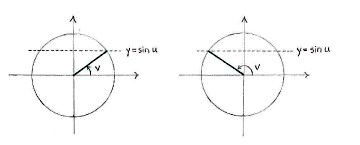Lösung 4.4:5a
Aus Online Mathematik Brückenkurs 1
If we consider for a moment the equality
\displaystyle \sin u=\sin v\quad \quad \quad (*)
where \displaystyle u has a fixed value, there are usually two angles \displaystyle v in the unit circle which ensure that the equality holds:
\displaystyle v=u
and
\displaystyle v=\pi -u
(The only exception is when
\displaystyle u={\pi }/{2}\;\text{ }
or
\displaystyle u=3{\pi }/{2}\;\text{ }, in which case
\displaystyle u
and
\displaystyle \pi -u\text{ }
correspond to the same direction and there is only one angle
\displaystyle v
which satisfies the equality.)
We obtain all the angles \displaystyle v which satisfy (*) by adding multiples of \displaystyle \text{2}\pi ,
\displaystyle v=u+2n\pi
and
\displaystyle v=\pi -u+2n\pi
where
\displaystyle n\text{ }
is an arbitrary integer.
If we now go back to our equation
\displaystyle \sin 3x=\sin x
the reasoning above shows that the equation is only satisfied when
\displaystyle 3x=x+2n\pi
or
\displaystyle 3x=\pi -x+2n\pi
If we make
\displaystyle x
the subject of each equation, we obtain the full solution to the equation:
\displaystyle \left\{ \begin{array}{*{35}l}
x=0+n\pi \\
x=\frac{\pi }{4}+\frac{1}{2}n\pi \\
\end{array} \right.

